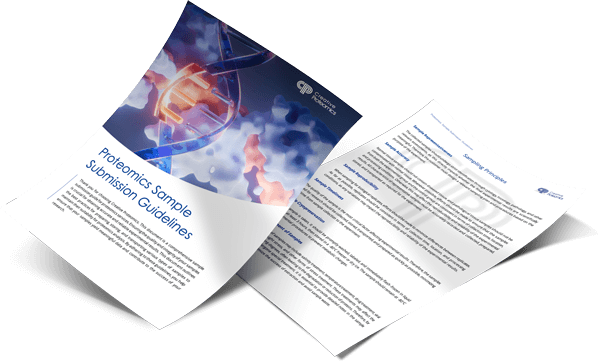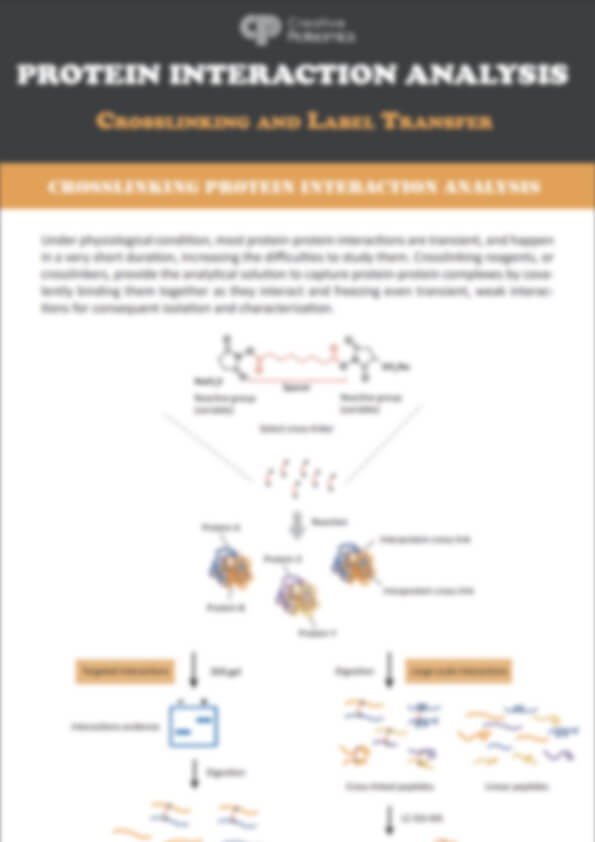What is crosslinking?
The crosslinking reagents are a class of small molecule compounds covalently connect interacting proteins, domains, or peptides in vivo or in vitro by forming chemical bonds between specific functional groups of amino acids in two or more biomolecules that are in close proximity due to their interaction, resulting in inter- or intramolecular linkage. According to their properties, cross-linking agents can be divided into photoreactive agents and chemical agents. Chemical cross-linking reagents usually contain two identical (homobifunctional, such as amine-to-amine, sulfhydryl-to-sulfhydryl) or two different (heterobifunctional, such as amine-to-sulfhydryl, carboxyl-to-amine) reactive groups as well as a linker. Additionally, there are photo-reactive crosslinkers such as UV-inducible amino acids like photo-methionine or photo-leucine.
Table 1 The information of some commonly used cross-linkers.
| Crosslinker | Residue reactivity | Spacer length/ Å | Character |
|---|---|---|---|
| DSS | K/ProN - K/ProN | 11.4 | Isotope labeled |
| BS3 | K/ProN - K/ProN | 11.4 | Isotope labeled |
| PIR | K/ProN - K/ProN | 43 | Enrichable/Isotope labeled/Cleavable |
| EDC | K/ProN - D/E | 0 | Heterobifunctional |
| DSBU | K/ProN - K/ProN | 12.5 | Cleavable |
| sulfo-SDA | K/ProN - any amino acid | 3.9 | Heterobifunctional |
| DSSO | K/ProN - K/ProN | 10.3 | Cleavable |
| CBDPS | K/ProN - K/ProN | 15 | Enrichable/Isotope labeled/Cleavable |
| Leiker | K/ProN - K/ProN | 10 | Enrichable/Isotope labeled |
| Diazoker | D/E - D/E | 15.6 | - |
| BMSO | C - C | 24.2 | Cleavable |
| NHSF | K/ProN - any amino acid | 7 | Heterobifunctional |
| PhoX | K/ProN - K/ProN | 5 | Enrichable |
| KArGO | K/ProN - R | 18.2 | Heterobifunctional |
Note: ProN means N terminal of Protein.
Why crosslinking is important for protein-protein interactions (PPIs) study?
The significance of crosslinking in PPIs study cannot be overstated. As it allows the identification and characterization of PPIs in their native cellular environment. The following are key aspects of crosslinking:
1) Stabilizing transient interactions. Many PPIs are transient and can be difficult to capture using conventional methods. Crosslinking helps to stabilize these interactions, allowing for their detection and analysis.
2) Preserving weak interactions during sample preparation. Sample preparation for protein interaction analysis often involves purification steps, protein extraction, and manipulation, which can disrupt or alter protein interactions, especially for weak interactions. Crosslinking ensures that interactions are preserved during these steps, providing a more accurate representation of the native interaction network.
3) Generating spatial proximity information and mapping protein interfaces. Crosslinking can provides spatial information about the proximity of interacting proteins and helps map the physical contacts between interacting proteins and by introducing covalent bonds between them. This information is valuable for the determination of distances and orientations between different regions of the proteins within the complex and understanding the binding surfaces and domains that contribute to PPIs.
4) Characterizing multi-protein complexes. Crosslinking can identify proteins that are proximal to each other within multi-protein complexes. By employing crosslinking, followed by proteomic analysis or quantitative proteomic analysis, it becomes feasible to ascertain and quantify the composition and arrangement of protein complexes as well as subcomplexes.
In summary, crosslinking is an essential technique in the analysis of protein interactions, as it aids in stabilizing, preserving, and characterizing PPIs both in vivo and in vitro. Consequently, it offers valuable insights into the organization and functionality of biological systems.
General Cross-Linking Protocol in Creative Proteomics
The technology has been successfully and widely employed for the acquisition of protein structural information and identification of PPIs. It offers several advantages, including minimal sample requirements, low environmental constraints on proteins, absence of molecular weight limitations, in-situ cross-linking capability, ease of operation, and generation of a substantial amount of information.
 Figure 1. General cross-linking -LC-MS workflow for PPI study [1].
Figure 1. General cross-linking -LC-MS workflow for PPI study [1].
The standard procedure of Crosslink-MS in our company is as follows:
1) Project and experimental design (In vivo crosslinking or in vitro crosslinking).
2) Crosslinking reagent selection.
If you aim to capture the native state structure of PPI, it is essential to conduct an intracellular cross-linking reaction. During this process, it is crucial to select a crosslinker capable of traversing the cell membrane, such as DSS.
3) Sample preparation and parameter optimization.
The maintenance of protein activity necessitates the execution of the crosslinking reaction under appropriate conditions. Special attention should be given to four key parameters: pH, temperature, the crosslinker concentration, and reaction time. The samples' optimal crosslinker and crosslinking reaction conditions will be determined through preliminary experiments.
4) Cell lysis.
5) One or Multiple proteases (Trypsin, Lys-C, Asp-N, Chymotrypsin, Glu-C, etc.) for sequential digestion or combined digestion.
6) Cross-linked peptides Enrichment.
- Affinity chromatography purification, such as streptavidin.
- Strong Cation Exchange (SCX).
- Size Exclusion Chromatography (SEC).
- Etc.
7) Analysis experiments (Electrophoresis, Western Blot, Co-IP, LC-MS/MS).
8) Report delivery.
With over a decade of experience in the field of proteomics, we possess exceptional proficiency in executing Crosslinking Protein Interaction Analysis Service Projects. The field of quantitative proteomics also has witnessed the establishment of various well-established techniques, including SILAC, iTRAQ/TMT, label-free, DIA and target quantification proteomics such as (SRM/MRM, PRM). We possess the capability to handle diverse sample types and deliver precise and comprehensive identification and quantification information regarding interacting proteins and their interaction sites.
Applications
1) Study transient or weak interactions in vivo PPIs.
2) Study low affinity in vitro PPIs.
3) Study location or structure of PPIs.
4) Targeted drug research.
5) Antibody labeling, label transfer, such as connect antibodies to enzymes, fluorophores or biotin for quantitative measurements or localization observations.
6) Connection of hapten to carrier protein.
Technologies platform
- Professional detection and analysis capability: Equipped with specialized technical team, strict quality control system, together with ultra-high resolution detection system and professional data pre-processing and analysis capability, ensure reliable and accurate data.
- High specificity and purification: Optimization of experimental design and methods.
- High stability and reproducible: Obtain consistent and reproducible inter- and intra- assay results for data analysis.
- High resolution and sensitivity: Triple TOF 5600, Q-Exactive, Q-Exactive HF, Orbitrap Fusion™ Tribrid™, etc.
- High selectivity: We can provide a wide range of multi-technological services and efficiently handle various types of samples, while remaining cost-effective and ensuring short turnaround times for your projects.
Results Delivery
- Detailed report, including experiment procedures, parameters, etc.
- Raw data and data analysis results (e.g. identified proteins and peptides, and optional bioinformatics analysis results, such as volcano plot, PCA, GO, KEGG, Protein Interaction Networks, etc.).
How to place an order
The provision of comprehensive support tailored to your specific requirements for Crosslinking Protein Interaction Analysis is our area of expertise. Please feel free to contact us via email whenever you need to discuss your specific requirements. Our customer service representatives are available 24 hours a day, from Monday to Sunday.

References
- Wheat A, Yu C, Wang X, et al. Protein interaction landscapes revealed by advanced in vivo cross-linking-mass spectrometry. Proc Natl Acad Sci U S A. 2021 Aug 10;118(32): e2023360118.
















